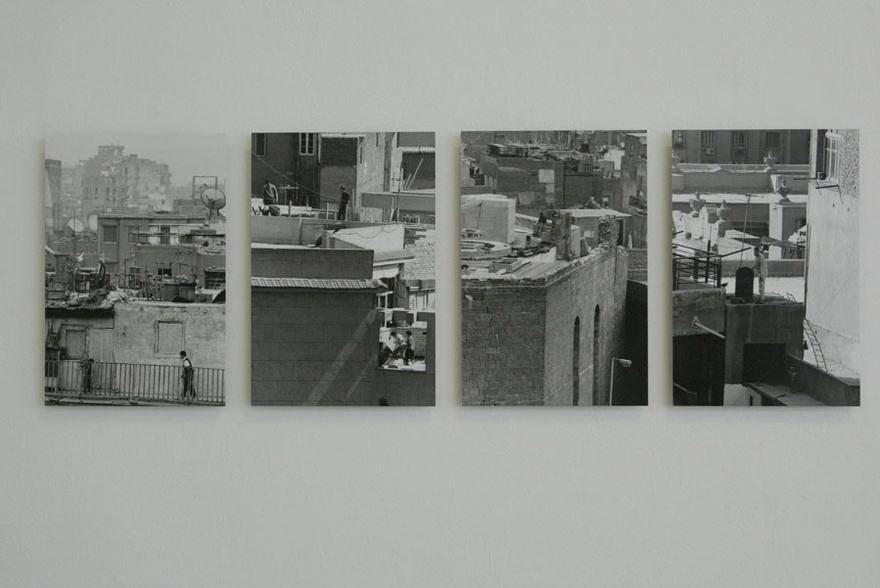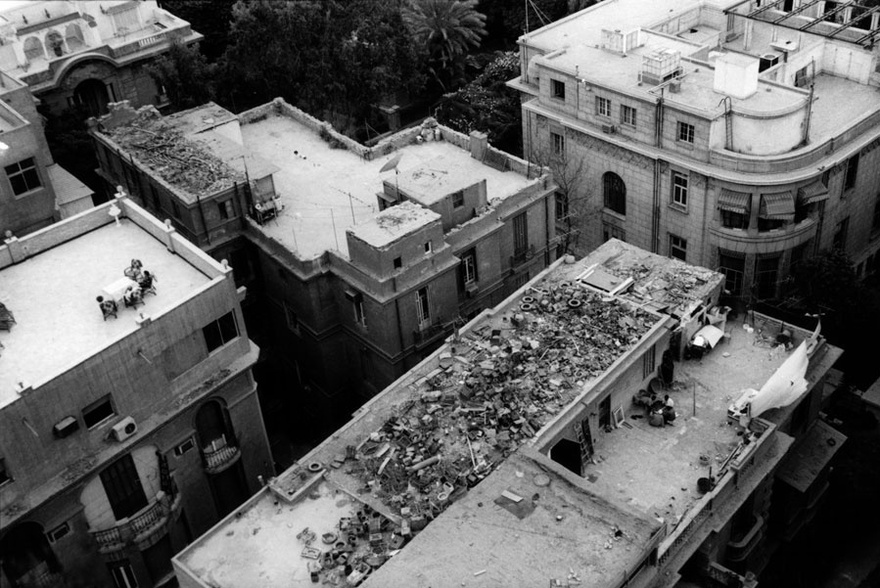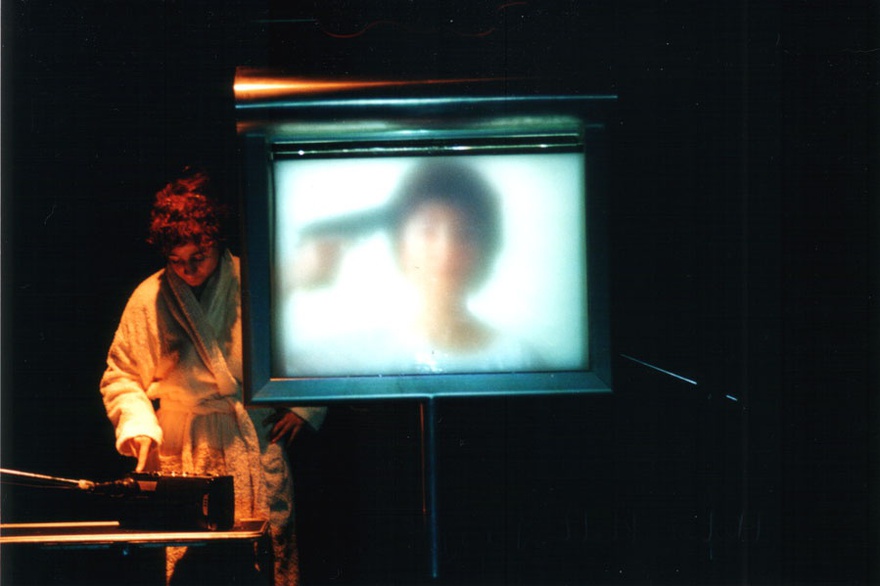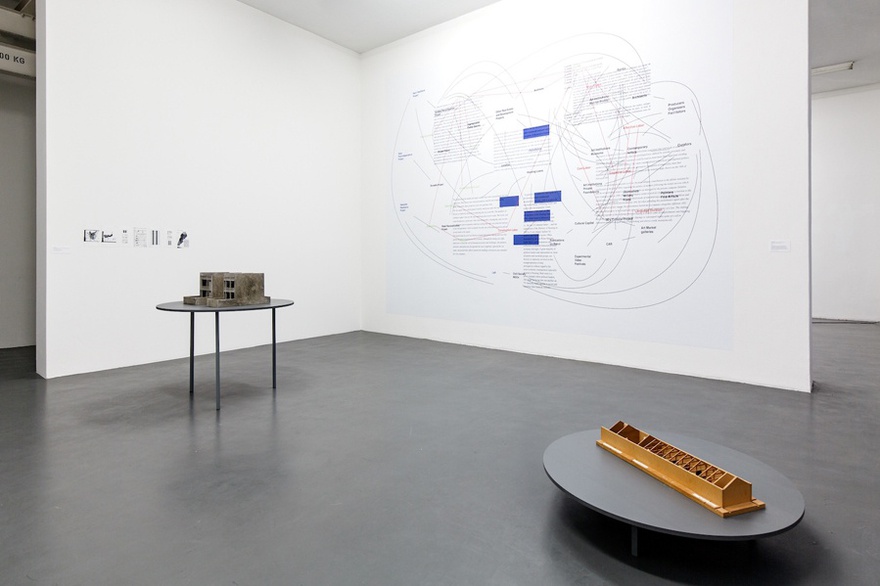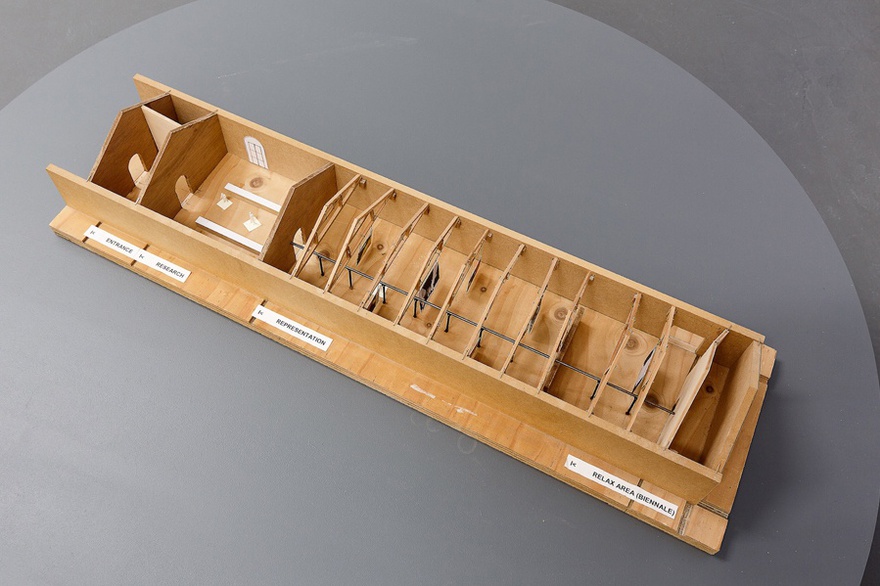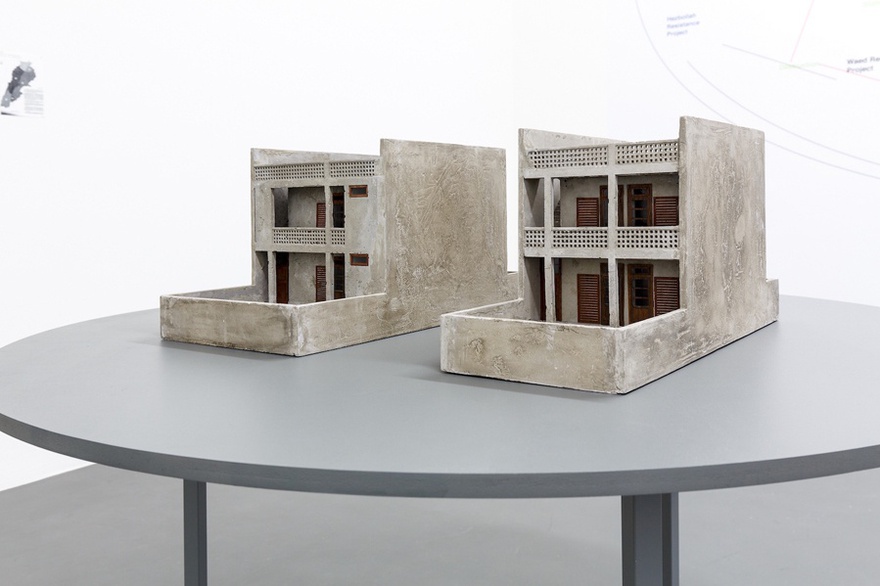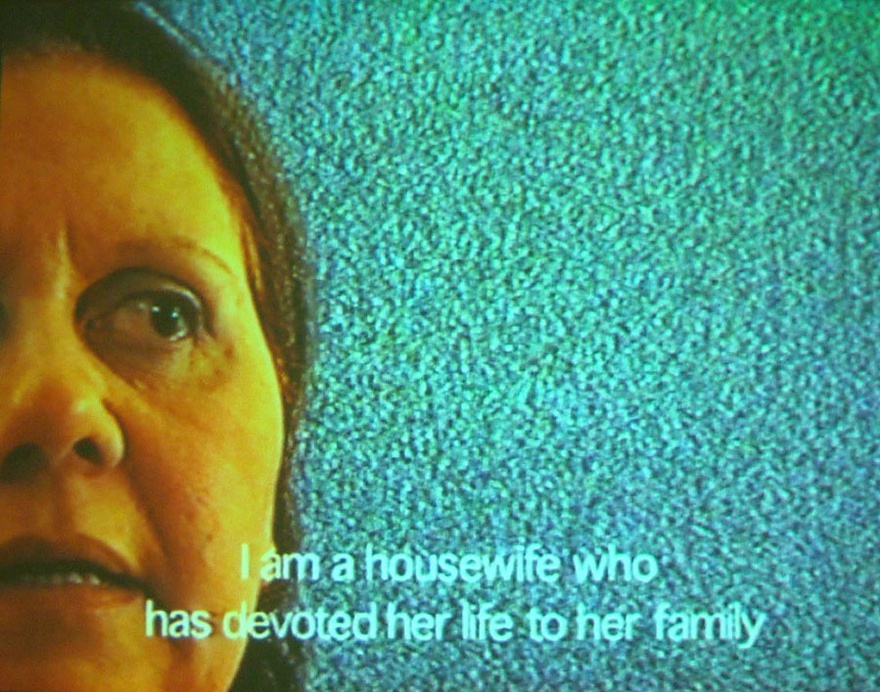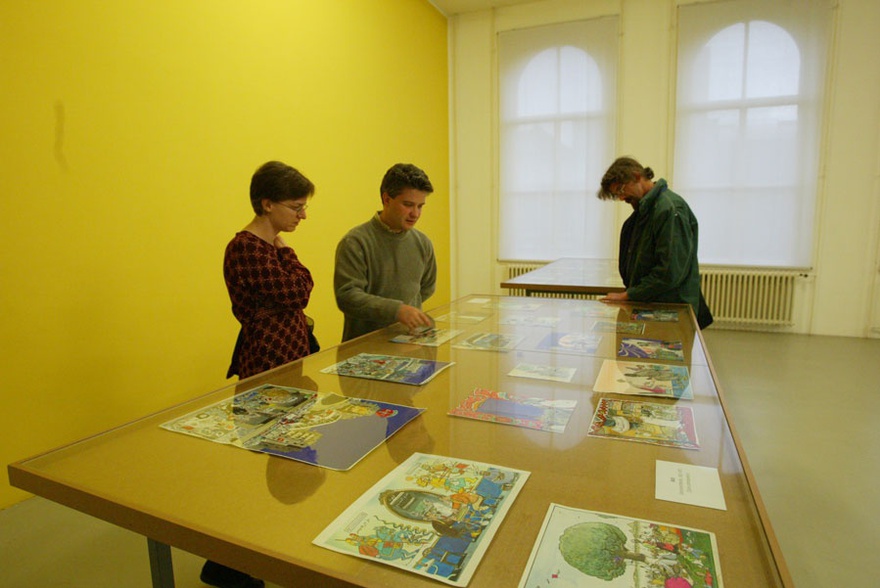Essays
What Representations?
Exhibitions and Other Representations in 25 Years at Witte de With
The life cycle of a contemporary art institution is an interesting thing. After five years, an institution might still seem like a giddy toddler. Ten years later, it might still show traces of an accumulated vision. But it is at 25 years that an institution really begins to represent a legacy, especially when considering the fast-changing geopolitical contexts, artistic turns, and the pushes and pulls from economic and market forces that an institution is influenced by.
Most of the time audiences are not privy to the internal workings of institutional exhibition making. They only get to see the final product: exhibitions, press releases, wall labels and sometimes some well-chosen process sketches. As audiences, we are not privy to the emails, notes, disagreements, installation drafts, staff meeting minutes and paperwork: motions that not only precede the realization of a project, but also reveal the array of forces that an institution must negotiate and navigate. No matter how well-crafted exhibition texts are at narrating the complexity of the process, curating is, to an extent, an exercise in feigned effortlessness. To this end, what better way to understand the life of an institution than by digging through its archives and looking at its exhibition history?
This is the logic that feeds into WDW25+, an exhibition project (running from 27 May–31 December 2016) celebrating the 25th anniversary of the Witte de With Center for Contemporary Art in Rotterdam, which includes contributions by Marwa Arsanios, Omar Berrada, Bik Van der Pol, and Kasper Bosmans. Beirut-based artist Marwa Arsanios' launched the project with an exhibition titled What Representations?, which opened on 26 May and occupied a quarter of Witte de With's two-floor exhibition space. At the crux of the show was an invitation to Arsanios to delve into the archives of the former Witte de With director Catherine David's long-term project Contemporary Arab Representations, Beirut/Lebanon.
The three chapters of Contemporary Arab Representations (CAR) were organized as individual exhibitions, accompanied by discursive events, which included seminars, publications, performances and presentations by visual artists, architects, writers and poets. A central concern of the project was how to incorporate this specific knowledge about certain parts of the Arab world into the premise of exhibition making. The first chapter explored Lebanon's and specifically Beirut's, post-civil war dynamics as well as the role of art and critical discursive practices herein, which is also where Arsanios places her focus. The original project was first shown at the Fundació Antoni Tàpies in Barcelona in the summer of 2002 and then travelled to Witte de With in the autumn of that same year. CAR continued with a look at the urban, poetic and political realities of contemporary Cairo and was shown at Witte de With in 2003. The third and final chapter on Baghdad, titled The Iraqi Equation, which opened in 2005 at Berlin's KW Institute for Contemporary Art, differed somewhat to the previous two chapters in that it did not propose a traditional exhibition. Rather, it intended to provide a platform for information and debate in which Iraqi artists, filmmakers, authors, analysts and activists who worked in the country or in exile participated, through various types of contributions, in order to shed light on the situation in Iraq, from the past to the present.
Both celebrated and criticized, much has been written about CAR's importance and effect in the region and beyond. Writing for Afterall, Pablo Lafuente notes on the title that although 'the elimination of the word 'art' clears the field of a set of problems; the word that David chose instead – 'representations' – as well as the one that accompanies it – 'Arab' – introduces new ones.'[1] Christopher Miles, reviewing CAR's Venice Biennale iteration in 2003, lamented that the latter's 'tone is so forcedly educational that it undermines any thought-provoking potential.'[2] However, in Bidoun, Abdellah Karroum underlines that CAR is 'a refreshing approach and a far cry from the trend common at L'Institut du Monde Arabe for example or the British Museum, where generic artist exhibitions are selected on the basis of national origin or identity only […] David seems to understand that one must look at a nation's history and literature, and beyond, to even begin to comprehend its artistic production.'[3]
Instead of getting into such arguments about the merits and faults of CAR and viewing Arsanios' exhibition through this lens, this text will explore what What Representations? puts in front of us: a critique of CAR articulated through a combination of her own work with the correspondence, exhibition notes and others documents, found in Witte de With's archive, in an act of repurposing, the artist turned this institutional material into her own. CAR was in essence a project showcasing discursive practices, and Arsanios made sure to echo this sensibility throughout her own project.
Preceding the opening of What Representations? a roundtable was held with academics and artists who are based in or are researching Beirut, including academic Hisham Ashkar, writer/architect Tony Chakar, writer/academic Ghalya Saadawi, academic Hanan Toukan and the artist herself. The intention was to map out a broader picture of the political and social contexts of Beirut in order to further understand the conditions out of which both CAR and Arsanios' show emerged.
The live roundtable formed the heart of the project. But for those who could not attend, the event was experienced via audio documentation presented in the first room of the Witte de With's exhibition space, where the object traces of the discussion were left. The table and chairs used for the roundtable were presented with headsets instead of microphones, so visitors could listen to the recording of the event. The overall sense of this installation was the transformation of a live event into an institutional archive – gone were the panellists, the audience, the clamour in the background, the whispers, the moderator, and other live elements. If viewers chose to skip the recording, for instance, or only listen to snippets of it, then the form of the roundtable took over instead. And here the props of the discursive event became a sculpture of sorts within the institutional white cube space. This set-up highlighted the generic, disembodied nature of the props used both for past and future debates – a blueprint, if you will, for a discursive and performative environment, facilitated in and by an art institution.
On the back wall of the same room where the roundtable recording was presented, a large infographic presented the exchanges of economic and symbolic value between real estate and housing projects (from as early as the 1950s) and Lebanon's post-civil war art scene. In this mapping, Arsanios connected the reconstruction of Beirut and older real estate projects with housing policies, municipal law, national debt, labour and the Lebanese banking system. All these nodes were then related to forces from the political left and civil society in Lebanon, which in turn linked to cultural actors and institutions – among them a node was even reserved for CAR. This was a complex cartography to decode, but Arsanios essentially showed how power, influence, capital, investment (private, public, international), influence (from certain curators, journalists, publications) have created the dynamics of the Lebanese art scene: the very thing Catherine David was interested in representing.
The artist's data visualizations seemed more subjective than the coolly objective form her installations prompted us to believe. This especially came to the fore in the second room of What Representations? where another large diagram on the wall displayed, among others details, excerpts from Lina Majdalanie's script of her performance Biokraphia: a piece on theatre, sexuality and censorship performed during CAR at Witte de With in 2002. The text was overlaid with the diagram in the first section of Arsanios' exhibition, but this time, it showed only the connecting lines without the nodes, making it impossible to find out what connects to what and leaving the connections broken and almost abstracted. The result of these markings was the suggestion that the first diagram was perhaps too neat and perfect to be true and that the reality is messy and less causal and logical than represented in the first piece. It is as though Arsanios wanted to show us the flip side of the same coin: that is, the difficulty of remembering (the war, the conditions that nurtured Beirut's cultural scene) and the struggle or inadequacy of representing those memories in an exhibition format.
Indeed, if the first room of Arsanios's exhibition was a contextualising opening act, presenting the ramifications of CAR for Beirut's art scene through the roundtable and the economic and geopolitical conditions that facilitated that very scene (as represented in that infographic), then the second room dove further into her reasoning behind the selection of archive material. The documents she chose for this space were devoid of information on the artworks themselves, except for Biokraphia. For example, a wooden scale model of CAR's exhibition layout produced for its iteration at the Arsenale at the 2003 Venice Biennale neatly showed David's curatorial logic: presenting research material first, followed by a selection of video screens suspended one after the other. In the same room, a shelf sporting the paper trail of CAR's exhibition making was also presented: floor plans, faxes, notes, photographs, as well as Arsanios' captivating abstract deconstructions of these very exhibition floor plans. She reduced them to lines only, either superimposing her infographic on them or combining them with photos of the hallway of Witte de With's exhibition spaces. Through a headset, the recording of Arsanios speaking about Biokraphia, the role of institutions, a visit to a museum involving mummies, as well as a recitation of items from which institutions are made – from light beams, excel sheets and garbage regulation, to its objects – could be heard.
Somehow, the scale model eerily echoed Walid Raad's miniature exhibition mock-ups for future Atlas Group exhibitions, of which Raad is the sole member and its archivist. Raad insists that these are not miniatures but are in fact shrunk down 1/100 of their size upon entering a white cube exhibition space in Beirut, thus making each shrunken exhibition inaccessible to the viewer. On this, Raad commented: 'Sometimes artists encounter their own works, concepts or forms, and they're no longer available to them.'[4] One wonders whether this sentiment is shared by Arsanios. Could there be a suggestion that the work of the artists who participated in CAR has, to an extent, become inaccessible to the artists themselves because it has been framed by CAR in a very particular way?
All these re-interpreted elements of CAR's archive were coupled with the artist's ongoing research into urban development in Lebanon, represented primarily by two understated concrete models of the Doxiadis social housing project. Before Lebanon's civil war (1975-90), many European urban planners, amongst them Constantinos Doxiadis, proposed master plans for the city of Beirut. Largely destroyed during the war, the reconstruction of downtown Beirut was taken on by Solidere, a private company founded by Rafic Hariri, Lebanon's on-and-off prime minister (who was assassinated in 2005). Much criticized and maligned, these reconstructions erased much of the original character and demographics of the city centre and turned it into a controlled and upscale zone with luxury apartments and upscale shops.
What emerged out of the exhibitions' two rooms is that throughout Lebanon's recent history, representations of Beirut have been tied to an economy of power, urban development, and selective acts of memory, or rather some forceful acts of forgetting. However, tying all these complex knots together requires quite a bit of prior knowledge of Beirut's current and past political context, its art scene, and its civil society movements that are still very much engaged with urban issues. To gain an understanding of all these aspects is to grapple with what Beirut is and means both as a city and as an idea.
*
It is wildly fascinating to get a partial glimpse (albeit curated and artistically interpreted) of the innards and decision-making processes of the institutional exhibition making process behind Contemporary Arab Representations project, given that anything that is presented and represented in an exhibition happens in the context of a particular time and place. Archives, like memories, are by default selective and can only tell you part of the story. It is close to impossible to record the affects a show might produce, or even recreate the ambience of a particularly successful opening. Thus, when institutions look back critically at their own exhibition history and curatorial practices, they are faced with the difficult task of considering how objects and subjects are remembered, who gets to speaks for them and on which terms.
If in 2002, however, David sought out to represent Beirut as a city and as an idea through the complexity of aesthetic practices by focusing on the politics of both the archive and representation, then in 2016 Arsanios attempted to quantify these very relations through her own artistic gestures. Both representations were fragmentary in nature and determined by gaps and omissions. In David's case, the representation of Beirut's contemporary art practices was a selected and curated project that favoured a certain type of practice, in particular works – predominately photography and video – probing the relation between truth and fiction, such as the Atlas Group/Walid Raad and the work of Rabih Mroué and Lina Majdalanie. In Arsanios' case, she very carefully chose how to engage with the material from Witte de With's archive. In fact, Arsanios shunned documentation, like video or photography, that could clarify what works were actually shown in David's exhibition. Instead, she worked with peripheral material like floor plans, faxes between institutions and other documents that served to mystify more than clarify.
Here lies the ultimate difference between the original project and its contemporary interpretation. Whereas with CAR, David intended to show some kind of truth about Beirut, Arsanios created a sense of doubt surrounding what was seen. Was this exhibition a work of fact, or fiction? Were these the actual archives of Witte de With that viewers saw, or something else? Perhaps this was not intentional, but the approach beautifully echoed the chief concerns of the generation of post-civil war artists that David was working with, such as the archival, the dearth of imagery and the thin lines between fact and fiction. In short, both David and Arsanios addressed the politics of memory – what is forgotten, left out, unmentioned or unseen – even if they did so with very different objectives in mind. Of course, all this might have remained oblique to a Witte de With visitor. As a result, the ideas that Arsanios was hinting at were at risk of remaining hidden to many. Yet, this might have been the exact point of Arsanios's critique: that unlike CAR, she chose to shy away from representation rather than make an attempt at it.
Nevertheless, taking into account the fact that What Representations? was staged in Rotterdam and based on a project conceived for this very space, it was unclear as to whom the artist was exactly speaking to or directing her critique at. This made What Representations? a rather difficult exhibition to access, even if this inaccessibility was the actual objective. Perhaps Beirut – or its art scene for that matter – simply cannot be explained through an exhibition project.
Returning briefly to the roundtable that kicked off What Representations?, the panellists made many excellent points. Indeed, CAR propelled certain artists, now known as the first post-civil war generation, and their specific practices onto the world stage, which willingly or unwillingly created a certain canon in Lebanon and abroad. Artists who participated in CAR such as Tony Chakar, Lina Majdalanie, Rabih Mroué, Walid Raad, Marwan Rechmaoui, Walid Sadek, Jalal Toufic, and Akram Zaatari are often grouped together as the aforementioned generation. These artists have used (visual) absence and disappearance as conceptual and aesthetic tropes and have confused the boundaries between fact and fiction within their work. They came of age during Lebanon's civil war (1975–90) and have, for more than 15 years, in a country still ridden by sectarian loyalties and the absence of accountability of the state, focused a large part of their work on dealing with the aftermath of the war. Such artists articulated a specific set of concerns, many about the murky waters of the politics of representation and, in a way, opened up avenues for a future generation to build upon, or discard. Their work was urgent, sprung out of necessity, and still carries enormous currency today. In the 1990s, Catherine David recognized this dynamic in their endeavours.
That being said, one exhibition and one curator alone, no matter how influential, cannot be credited nor blamed for the traction this garnered. If, as Ghalya Saadawi suggested at the roundtable, the very canonization that David played a part in creating needs to be undone, then I would argue it is up to Lebanese artists and Lebanese institutions to make the diversity of their voices heard. This, as Arsanios' diagram illustrated, is not always an easy feat. Foreign funding and institutional realities in Lebanon create certain dependencies and, by corollary, certain expectations. In addition, as Saadawi pointed out, CAR did create a blueprint for aspiring artists to understand what type of art would be expected from them and perhaps what art might do well abroad. In this sense, the roundtable effectively answered a fair and valid question that Hanan Toukan raised during the discussion: 'If CAR was about bringing stories of Arabs to the West', then, 'What did it do for us?'
But what was a lost opportunity, if not a major omission, is that while discussing CAR in the very venue the exhibition was held in 2002, the panel failed to acknowledge the local context of the show and what it did for Rotterdam. Indeed, despite the problematic framing of CAR – in particular the confusion about who is representing 'whom' for 'what', or 'what' is representing 'whom' and 'how' – the project had quite an impact on the 'where'. Here, it is important to acknowledge the fact that the project was both initiated by and staged at a contemporary art space in Europe – Rotterdam – in the early 2000s, just a year after 9/11, and way before the Arab art hype that would follow a few years later.
In this regard, context is everything when thinking about a project such as CAR. At the time, xenophobia in Europe and the Netherlands in particular, soared. The right-wing populist party Leefbaar Rotterdam, following in the footsteps of the controversial Dutch populist far-right politician Pim Fortuyn, who was assassinated in 2002, was the largest party in Rotterdam's municipal council. (Fortuyn's views on Islam and immigration were reprehensible.) Just two years after the exhibition was staged here, the film director Theo van Gogh was assassinated because of an anti-Islam film he produced with Ayaan Hirsi Ali, and Rita Verdonk became Netherlands' most hawkish Minister for Integration and Immigration the country had ever seen. The political atmosphere was nasty, conservative and dismissive of anything that even remotely represented 'difference'. To open a show of contemporary art from Beirut and a year later from Cairo in such a climate, and to insist these practices ought to be viewed as contemporary art in a contemporary art space and not through an ethnographic or activist lens, was crucial. On a curatorial level these types of gestures have hardly been repeated in the Netherlands since.
I remember vividly visiting and revisiting Contemporary Arab Representations, Beirut/Lebanon at Witte de With in 2002. The exhibition was particularly meaningful, as someone in the audience at the roundtable debate commented, because '[f]or a Rotterdam audience it made a big difference to have a critical view on how we were presenting art and shows'. For me, it signified an entry point into the Lebanese art world, but this does not mean it was an end point. Fifteen years on, regardless of CAR's curatorial and other flaws, we haven't really moved on in the Netherlands. Artists from the Arab world are, with few notable exceptions, largely ignored or underrepresented by contemporary art institutions. Of course, institutions and festivals might feature their work, but usually the incentive is didactic as much as it is othering: predicated on creating 'intercultural dialogue' or seeing the work through the narrow scope of revolutionary art or art in conflict.
If anything, CAR laid a foundation, however unstable, for future debate: one that was unfortunately not picked up in the Netherlands. Despite all the buzz about diversity and decolonizing practices in the Dutch art world, an incredible amount of work still needs to be done to put this into practice and anchor it in the DNA of art institutions, particularly in terms of curatorial and collecting policies. For the Netherlands, this might mean finally coming to terms with, and acknowledging its mercenary colonial exploits in Indonesia and discarding the heroic narrative of the West India Company and its seventeenth-century 'Golden Age'. Acknowledging historical wrongdoings and taking accountability are big challenges for nation states. This is true for the Netherlands, and it is most certainly true for Lebanon, where sectarian politics perpetuate a state of inertia that, to a large extent, freezes and even sabotages a historical reckoning and any progressive ideas.
Arts organizations are of course not comparable to nation states, yet looking back, as Witte de With is doing with its own archive, counters forgetfulness. An interesting sequel in the case of CAR would be to not only look at it through the eyes of its subject(s) – for example, those directly involved in and with the Lebanese art scene – but also to acknowledge how local institutional politics and wider geopolitics and temporalities frame the complexities of exhibition making.
[1] Pablo Lafuente, 'Art and the Foreigner's Gaze: A Report on Contemporary Arab Representations', Afterall, (Volume 15 Spring/Summer). http://www.afterall.org/journal/issue.15/art.and.foreigners.gaze.report.contemporary.arab.r [last accessed 30.08.2016]
[2] Christopher Miles, 'A Visual "Dictatorship" along Venice's Canals', Los Angeles Times, (18 June 2003). http://articles.latimes.com/2003/jun/18/entertainment/et-miles18 [last accessed 30.08.2016]
[3] Abdellah Karroum, 'Contemporary Arab Representations. Act III. (The Iraqi Equation)', Bidoun (Issue #8). http://bidoun.org/articles/contemporary-arab-representations-act-iii-the-iraqi-equation [last accessed 30.08.2016]
[4] Eva Respini, 'Slippery Delays and optical Mysteries: The Work of Walid Raad' in Walid Raad (New York: The Museum of Modern Art, 2015), p.42

